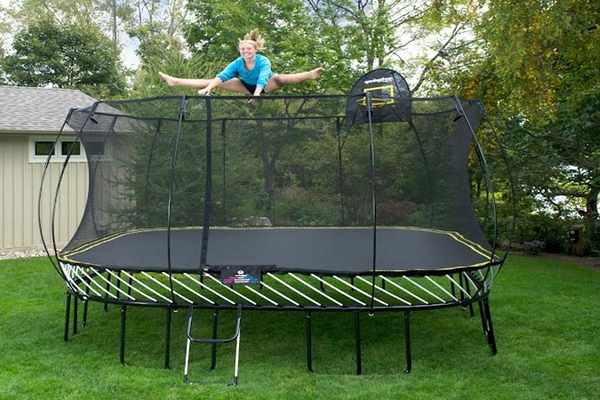
Everything You Need to Know About Trampoline Types
Trampolines are a backyard staple, and there’s a good chance we’ve seen a ton of them without giving them any thought. But if you ever thought they were all the same, you should think again.
Of course, they do serve the same general purpose - to bounce up and down. But beyond that simple mechanism, there are different trampoline types and they all function a bit differently. Different types also have different uses. The trampoline that you have in your backyard will have quite a few differences from the trampolines used at a professional gymnastics center.
Read on to find out all about trampoline types and their components.

Different trampoline types
Rebounders and mini trampoline types - These are the tiny trampolines you often see used in exercise videos. They’re only meant for one person to use at a time and are meant to assist you in getting your heart rate up while doing aerobic activities. The low-impact bouncing makes them a popular choice since you can avoid the joint stress that comes with running while still getting a great workout. They’re also typically small enough to store under the bed or in a closet, so they’re perfect for people in small apartments and homes.
Recreational trampolines - Recreational trampolines are the type of trampolines you find in backyards. There are a lot of different trampolines available that fit into this category and they range in size shape and price.
Circular trampolines are the most common type of backyard trampoline and generally regarded as the safest. There are many safety accessories available to minimize the risk of injury. The even rebound action tends to keep users towards the center of the mat as well, reducing the chance of accidents. The frames are also fairly lightweight, making it easy to transport and set up.
Rectangular trampolines provide greater jumping power because of the spring layout, but they are usually considerably more expensive than a circular option. The frames are generally made of heavy steel which is great for durability but can make it difficult to move. Rectangular trampolines leave jumpers more prone to injury than the circular option - if a jumper bounces too close to the edge or corner they can get an unexpected and forceful rebound that can cause injury.
Olympic trampolines - These are the largest and most expensive trampolines out there - and for good reason. These trampolines are specifically designed to provide massive amounts of bouncing power to the user, so they’re often found in gymnastic facilities and at professional competitions. They use a different material for the jumping mat than the ones on backyard trampolines. It’s a much more porous surface which makes it more responsive to the jumper’s movements. They are also equipped with thicker safety padding around the edges.
Different types of trampoline mats
Without a responsive mat, trampolines wouldn’t be able to function. Mats are typically made of tightly woven material. Polypropylene is the most popular choice for recreational trampolines because of its flexibility, strength, and ability to resist the outdoor weather conditions. Though you can still find some recreational trampolines that have mats made of canvas, they are fading in popularity. Rebounder trampolines also utilize polypropylene while professional trampolines use strong fabrics.
Different types of trampoline springs
Springs are a crucial part of any trampoline. They expand and recoil to create the bouncing motion.
The majority of trampolines have metal springs constructed from steel. These are popular because they are incredibly durable and keep their shape through heavy use. Steel springs can then be galvanized, which is a process where the steel is covered in a zinc coating, to prevent rusting and corrosion. Springs also vary in size, which can affect the bounciness and action of the trampoline.
There are also some springless trampolines available that use heavy elastic instead of steel springs. While this model can work well for small rebounders, elastic springs generally don’t hold up well enough to endure heavy recreational use.
Trampoline enclosure types
Safety is always a concern with trampolines and one of the most common types of accidents occurs when a user bounces off the trampoline and onto the hard ground below. This can be prevented by adding a trampoline enclosure. The nets are supported around the perimeter of the trampoline by a series of padded poles.
Netting is usually made of either polyester or polyethylene. Both of these materials are extremely durable and strong enough to support someone the bounces into it while the trampoline is in use. Polyethylene is a bit more affordable than the polyester alternatives, and can often be found in a variety of fun colors. In either case, it’s important to check that the net is UV resistant to minimize the chances of it falling apart once it’s exposed to the sun and other elements.
What is the safest type of trampoline?
While accidents can happen to anyone on any trampoline type, there are some precautions that can be taken to prevent the risk of injury.
Round trampolines lend themselves to being safer since the rebound tends to keep bouncers in the center. That being said, it’s important to have protective padding covering the springs and a good safety enclosure around the perimeter. The best safety nets will attach to the inside of the jumping surface to prevent contact with the springs and from anyone falling out.
If you’re looking to eliminate the threat of springs entirely, there are springless trampolines. While these eliminate the springs, there is still a risk of other injuries.
What type of trampoline is the bounciest?
The bounciest trampolines will always be those of professional quality. Because of their size and cost, these trampolines are usually found only in gymnastics clubs and other professional venues.
Recreationally, the bounciest trampolines are rectangular shaped. The alignment of the springs allows for bigger bounces and higher jumps.
Choosing the right trampoline type
With so many options on the market, you’ll probably find yourself wondering what is the best kind of trampoline to buy.
Trampolines are a big investment, and it’s important to choose a new one carefully. You’ll want to take into consideration what its intended use will be, who will be using it, and where it will be placed before you buy.
Thankfully, there are many different trampoline types available to suit a variety of different circumstances, and there's surely one out there to fit your needs.

